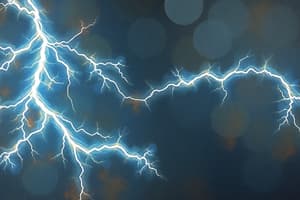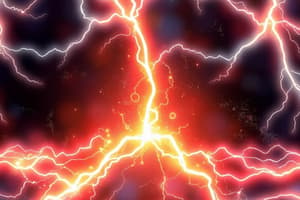Podcast
Questions and Answers
What is the primary unit of measurement for electric current?
What is the primary unit of measurement for electric current?
- Volts (V)
- Amperes (A) (correct)
- Coulombs (C)
- Ohms (Ω)
How is an ammeter positioned in a circuit to effectively measure current?
How is an ammeter positioned in a circuit to effectively measure current?
- At the end of the circuit
- In parallel with the load
- In series with the load (correct)
- Connected across the power supply
Calculate the amount of electric charge that flows through a circuit if a current of 5 A flows for 2 hours.
Calculate the amount of electric charge that flows through a circuit if a current of 5 A flows for 2 hours.
- 10000 C
- 500 C
- 12000 C
- 36000 C (correct)
Which of the following correctly describes electric current?
Which of the following correctly describes electric current?
What does the current of 10 A represent in a given circuit?
What does the current of 10 A represent in a given circuit?
What is the SI unit of charge?
What is the SI unit of charge?
What charge does a proton carry?
What charge does a proton carry?
How can charged bodies be created?
How can charged bodies be created?
What change occurs to an atom when it gains an electron?
What change occurs to an atom when it gains an electron?
What does 'q' represent in the context of charge?
What does 'q' represent in the context of charge?
Which substance is classified as a conductor?
Which substance is classified as a conductor?
What defines the conductivity of a semiconductor?
What defines the conductivity of a semiconductor?
What is the charge of a single electron?
What is the charge of a single electron?
How many electrons correspond to a charge of 3.2 x 10^-19 C?
How many electrons correspond to a charge of 3.2 x 10^-19 C?
Which of the following is an example of an insulator?
Which of the following is an example of an insulator?
Which formula is commonly used to calculate resistance in an electrical circuit?
Which formula is commonly used to calculate resistance in an electrical circuit?
In the context of a V-I graph, what does a positive slope indicate about the relationship between voltage and current?
In the context of a V-I graph, what does a positive slope indicate about the relationship between voltage and current?
If the current (I) in a circuit is halved while the voltage (V) remains constant, what happens to the resistance (R)?
If the current (I) in a circuit is halved while the voltage (V) remains constant, what happens to the resistance (R)?
Which set of variables can be manipulated to observe changes in resistance in an experiment?
Which set of variables can be manipulated to observe changes in resistance in an experiment?
Which statement best describes the concept of resistance in an electrical circuit?
Which statement best describes the concept of resistance in an electrical circuit?
What is primarily responsible for maintaining the flow of electric current in a conductor?
What is primarily responsible for maintaining the flow of electric current in a conductor?
What do electric charges move from and to when flowing through a conductor?
What do electric charges move from and to when flowing through a conductor?
Which component is responsible for providing the potential difference in an electrical circuit?
Which component is responsible for providing the potential difference in an electrical circuit?
What term is synonymous with potential difference in the context of electric current?
What term is synonymous with potential difference in the context of electric current?
What would likely happen if no potential difference exists across a conductor?
What would likely happen if no potential difference exists across a conductor?
What unit is used to measure the opposition to current flow in an electrical circuit?
What unit is used to measure the opposition to current flow in an electrical circuit?
How is power calculated in terms of voltage and resistance?
How is power calculated in terms of voltage and resistance?
Which of the following components is measured in Farads?
Which of the following components is measured in Farads?
What is the standard unit of electrical charge?
What is the standard unit of electrical charge?
Which of the following statements is true regarding an electric circuit?
Which of the following statements is true regarding an electric circuit?
What is the function of a switch in an electrical circuit?
What is the function of a switch in an electrical circuit?
How is a variable resistor (rheostat) different from a regular resistor?
How is a variable resistor (rheostat) different from a regular resistor?
What does Ohm's Law describe?
What does Ohm's Law describe?
In a circuit diagram, what does crossing wires without joining indicate?
In a circuit diagram, what does crossing wires without joining indicate?
What is the primary purpose of a battery in an electrical circuit?
What is the primary purpose of a battery in an electrical circuit?
What is the key characteristic of current in a series circuit?
What is the key characteristic of current in a series circuit?
Which equation correctly represents the relationship of currents in parallel resistors?
Which equation correctly represents the relationship of currents in parallel resistors?
What is true about equivalent resistance in a parallel circuit?
What is true about equivalent resistance in a parallel circuit?
What does the equation $I_1 R_1 = I_2 R_2 + I_3 R_3$ represent in the context of circuits?
What does the equation $I_1 R_1 = I_2 R_2 + I_3 R_3$ represent in the context of circuits?
If a complex circuit consists of both series and parallel components, which is the first step in analyzing it?
If a complex circuit consists of both series and parallel components, which is the first step in analyzing it?
What does the formula $H=I^2Rt$ represent regarding a rheostat?
What does the formula $H=I^2Rt$ represent regarding a rheostat?
Which component adjusts the resistance in a rheostat circuit?
Which component adjusts the resistance in a rheostat circuit?
In using a rheostat, which factor does NOT affect the amount of heat produced?
In using a rheostat, which factor does NOT affect the amount of heat produced?
Which element does NOT typically appear in a diagram of a rheostat circuit?
Which element does NOT typically appear in a diagram of a rheostat circuit?
If the current flowing through a rheostat doubles, what happens to the heat produced?
If the current flowing through a rheostat doubles, what happens to the heat produced?
Which factor does not affect the electrical resistance of a material?
Which factor does not affect the electrical resistance of a material?
What is the relationship between cross-sectional area and electrical resistance?
What is the relationship between cross-sectional area and electrical resistance?
Which of the following equations is most closely associated with calculating resistance?
Which of the following equations is most closely associated with calculating resistance?
What effect does temperature have on the resistivity of most conductive materials?
What effect does temperature have on the resistivity of most conductive materials?
Which of the following is a key concept linked to understanding electrical resistance?
Which of the following is a key concept linked to understanding electrical resistance?
Flashcards are hidden until you start studying
Study Notes
Charge
- Charge is a fundamental property of matter that causes electrical and magnetic effects.
- The SI unit of charge is the Coulomb (C).
- Charge exists on elementary particles like electrons (-) and protons (+). Neutrons are neutral.
- Charge is denoted by the symbol 'q'.
- A proton has a charge of +1.6 x 10⁻¹⁹ coulombs (e = 1.6 x 10⁻¹⁹ C).
Electrical Properties of Substances
- Conductors: Allow electrons to flow freely. Examples include iron, silver, and copper.
- Semi-Conductors: Have electrical conductivity between conductors and insulators. Examples include Germanium and Arsenic.
- Insulators: Resist the flow of electrons. Examples include wood, glass, and certain polymers.
Quantized Nature of Charge
- Charge is quantized, meaning it exists in discrete units.
- The smallest unit of charge is the elementary charge (e), approximately 1.6 x 10⁻¹⁹ C.
- All charges are multiples of this fundamental charge.
Electric Current
- Electric current is the rate of flow of charge through a cross-section of a conductor per unit time.
- The unit of electric current is the Ampere (A).
- An ammeter measures electric current in a circuit and is always connected in series.
Calculating Number of Electrons
- To find the number of electrons in a given charge, divide the total charge by the elementary charge (e).
- For example, a charge of 3.2 x 10⁻¹⁹ C corresponds to two electrons.
Electric Circuit Components
- Voltage (V): Electrical potential difference, measured in volts.
- Resistance (R): Opposition to current flow, measured in ohms.
- Current (I): Rate of flow of electric charge, measured in amperes.
- Charge (Q): Quantity of electric charge, measured in coulombs.
- Power (P): Rate at which energy is transferred, measured in watts.
- Energy (E/W): Measure of work done, measured in joules or kilowatt-hours.
- Capacitance (C): Ability to store electric charge, measured in farads.
- Inductance (L): Ability of a circuit to store energy in a magnetic field, measured in henries.
- Impedance (Z): Opposition to AC current, measured in ohms.
- Frequency (Hz): The number of complete cycles per second, measured in Hertz.
- Conductance (S): Reciprocal of resistance, measured in Siemens.
Electrical Circuit Calculations
- Work done: W = Q * V (Work = Charge * Voltage)
- Power, voltage, and resistance: P = V²/R (Power = Voltage squared / Resistance)
Electric Circuit Concepts
- An electric circuit is a continuous and closed path for the flow of electric current.
Commercial Units of Energy
- Joules (SI unit)
- Kilowatt-hours (kWh)
Rheostat Working
- Formula: H = I²Rt (Heat produced is proportional to the square of current, resistance, and time).
- Diagram: A rheostat circuit features screw adjustments to introduce variable resistance.
- A rheostat acts as a variable resistor in a circuit to control current flow.
Studying That Suits You
Use AI to generate personalized quizzes and flashcards to suit your learning preferences.




